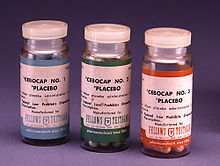
Back Plasebo AF ፕላሤቦ AM علاج وهمي Arabic علاج وهمى ARZ Sustancia placebo AST Plasebo AZ Плацебо BA Плацебо Bulgarian ছলৌষধ Bengali/Bangla Placebo BS

A placebo (/pləˈsiːboʊ/ plə-SEE-boh) is a substance or treatment which is designed to have no therapeutic value.[1] Common placebos include inert tablets (like sugar pills), inert injections (like saline), sham surgery,[2] and other procedures.[3]
Placebos are used in randomized clinical trials to test the efficacy of medical treatments. In a placebo-controlled clinical trial, any change in the control group is known as the placebo response, and the difference between this and the result of no treatment is the placebo effect.[4] Placebos in clinical trials should ideally be indistinguishable from so-called verum treatments under investigation, except for the latter's particular hypothesized medicinal effect.[5] This is to shield test participants (with their consent) from knowing who is getting the placebo and who is getting the treatment under test, as patients' and clinicians' expectations of efficacy can influence results.[6][7]
The idea of a placebo effect was discussed in 18th century psychology,[8] but became more prominent in the 20th century. Modern studies find that placebos can affect some outcomes such as pain and nausea, but otherwise do not generally have important clinical effects.[9] Improvements that patients experience after being treated with a placebo can also be due to unrelated factors, such as regression to the mean (a statistical effect where an unusually high or low measurement is likely to be followed by a less extreme one).[10] The use of placebos in clinical medicine raises ethical concerns, especially if they are disguised as an active treatment, as this introduces dishonesty into the doctor–patient relationship and bypasses informed consent.[11]
Placebos are also popular because they can sometimes produce relief through psychological mechanisms (a phenomenon known as the "placebo effect"). They can affect how patients perceive their condition and encourage the body's chemical processes for relieving pain[10] and a few other symptoms,[12] but have no impact on the disease itself.[9][10]
- ^ Cite error: The named reference
aspmnwas invoked but never defined (see the help page). - ^ Gottlieb S (18 February 2014). "The FDA Wants You for Sham Surgery". Wall Street Journal. Retrieved 8 January 2015.
- ^ Lanotte M, Lopiano L, Torre E, Bergamasco B, Colloca L, Benedetti F (November 2005). "Expectation enhances autonomic responses to stimulation of the human subthalamic limbic region". Brain, Behavior, and Immunity. 19 (6): 500–509. doi:10.1016/j.bbi.2005.06.004. PMID 16055306. S2CID 36092163.
- ^ Cite error: The named reference
chaplinwas invoked but never defined (see the help page). - ^ Blease C, Annoni M (April 2019). "Overcoming disagreement: a roadmap for placebo studies". Biology & Philosophy. 34 (2). doi:10.1007/s10539-019-9671-5. ISSN 0169-3867.
- ^ "placebo". Dictionary.com. 9 April 2016. Retrieved 21 January 2017.
- ^ "placebo". TheFreeDictionary.com. Retrieved 21 January 2017.
- ^ Schwarz, K. A., & Pfister, R.: Scientific psychology in the 18th century: a historical rediscovery. In: Perspectives on Psychological Science, Nr. 11, pp. 399–407.
- ^ a b Cite error: The named reference
CochraneHrob2010was invoked but never defined (see the help page). - ^ a b c "Placebo Effect". American Cancer Society. 10 April 2015. Archived from the original on 2020-05-22. Retrieved 2021-06-27.
- ^ Newman DH (2008). Hippocrates' Shadow. Scribner. pp. 134–159. ISBN 978-1-4165-5153-9.
- ^ Cite error: The named reference
quattrone-barbagallowas invoked but never defined (see the help page).